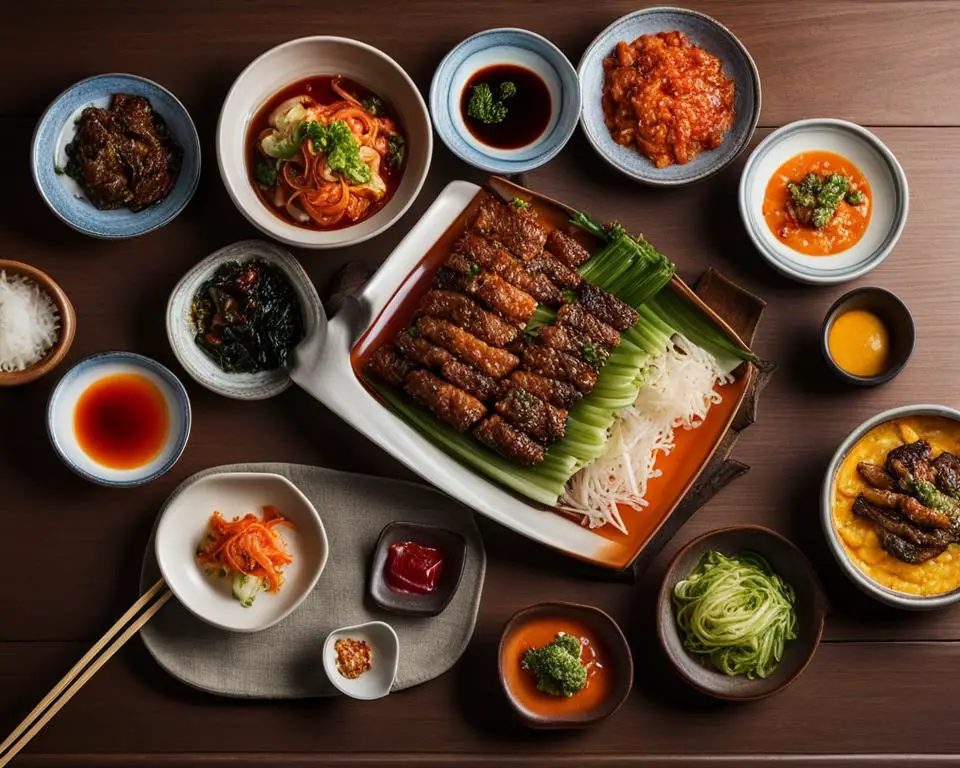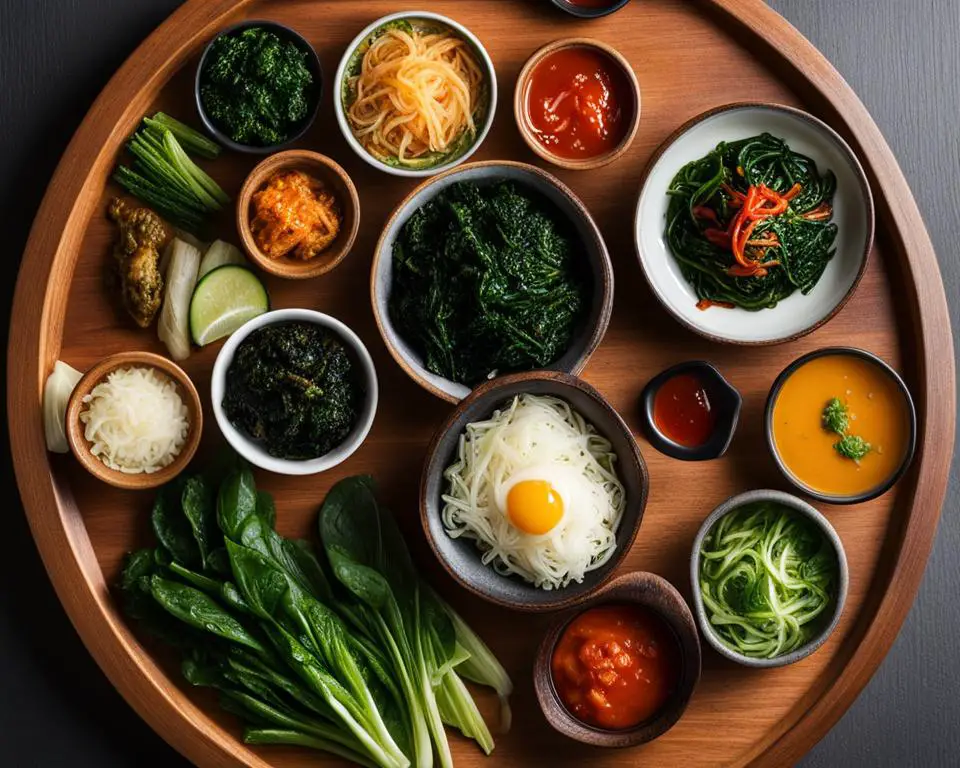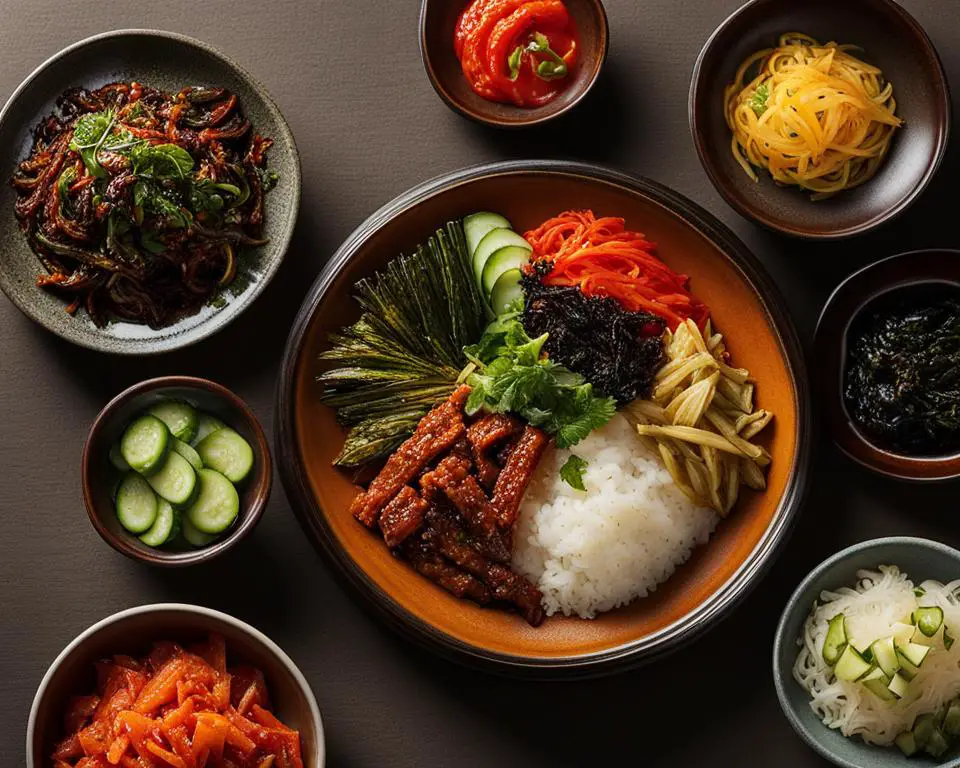Welcome to our comprehensive guide to Korean side dishes, also known as banchan! Whether you’re a fan of traditional Korean dishes or looking for easy and healthy options, we’ve got you covered. Koreans consider banchan an essential part of any meal and value the balance of flavors and nutrition they provide. In this article, we will explore the best recipes and cooking techniques for making delicious banchan at home. From spicy kimchi to refreshing salads, we’ll show you how to create a variety of dishes that will complement any meal. Let’s dive into the world of Korean side dishes!
Exploring Traditional Korean Side Dishes
Traditional Korean side dishes, known as banchan, are an essential part of Korean cuisine. These dishes are usually served in small portions to accompany a main course and create a well-rounded meal that embraces a range of flavors and textures. From spicy to savory, these side dishes are a great way to explore the many tastes that Korean cuisine has to offer.
Some of the most popular traditional Korean side dishes are:
Kimchi
Kimchi is a staple in Korean cuisine and is made of fermented vegetables, usually napa cabbage or radish. The fermentation process creates a unique sour and spicy flavor that adds depth to any dish. Kimchi can also be enjoyed on its own and is often praised for its health benefits, such as improving digestion and boosting the immune system.
Japchae
Japchae is a classic Korean noodle dish that is often served as a side dish. It is made of sweet potato noodles, stir-fried with vegetables and meat or seafood. The dish is full of flavors and textures, with a slightly sweet and savory taste that pairs perfectly with any main course.
Pajeon
Pajeon is a savory Korean pancake that is made of green onions, seafood, and vegetables. This dish is often enjoyed as a snack or appetizer and is perfect for sharing with friends and family.
These dishes are just a few examples of the many traditional Korean side dishes that you can try. Whether you’re a fan of spicy flavors or prefer something mild, there’s a banchan recipe out there that will suit your taste buds.
Easy Korean Side Dishes for Everyday Cooking
Want to add Korean banchan to your meal but don’t have the time for elaborate dishes? Try these easy Korean side dishes that you can whip up in no time:
- Bibim Naengmyeon: Enjoy a refreshing cold noodle dish with just a few ingredients. Boil the noodles and toss them in a spicy sauce made with soy sauce, vinegar, sugar, and gochujang.
- Pajeon: Craving pancakes? Make Korean scallion pancakes with flour, eggs, scallions, and a few additional ingredients. Pair with a soy dipping sauce for extra flavor.
- Gyeran Mari: This rolled egg dish is simple yet mouth-watering. Beat eggs with salt and sesame oil, cook in a pan, and roll it up with seaweed. Slice and serve as a cute and easy banchan.
Not sure where to start? Don’t worry, we’ve got you covered. Check out our beginner’s guide to Korean cooking for more recipes and tips.

Healthy Korean Side Dishes: Nutritious and Delicious
When it comes to Korean cuisine, banchan is an essential component that adds depth and flavor to any meal. If you’re looking for a healthier alternative to traditional side dishes, Korean cuisine has got you covered. From vitamin-rich namul to light and refreshing salads, there are a plethora of healthy Korean side dishes that you can easily make at home.
One of the most popular healthy Korean side dishes is the ubiquitous namul. Made with a variety of fresh vegetables like spinach, bean sprouts, and radish, namul is known for its nutrient-packed goodness. These dishes are perfect for vegetarians or those who are watching their calorie intake.
Another refreshing option is the Korean cucumber salad, or oi muchim. Made with thinly sliced cucumbers, red chili flakes, garlic, and vinegar, the oi muchim is a tangy and healthy addition to any meal.
If you’re looking for something a bit heartier, try the Korean sweet potato noodles, or japchae. Made with sweet potato noodles and a variety of vegetables, this dish is both delicious and filling. The noodles are low in calories and high in fiber, making it a great alternative to traditional pasta dishes.
Discover the Benefits of Healthy Korean Side Dishes
Not only are Korean side dishes delicious, but they also offer numerous health benefits. Many of the dishes are made with fresh vegetables, which are high in fiber, antioxidants, and vitamins. Korean cuisine also emphasizes balance, which means that the side dishes are typically less salty and fatty than other types of food.
By incorporating healthy Korean side dishes into your diet, you can enjoy delicious, flavorful food while still promoting a balanced and nutritious diet.
Popular Korean Side Dishes for Every Occasion
When it comes to Korean cuisine, banchan- the highly versatile side dishes – is what makes the meal unique and enjoyable. Whether you’re eating out or cooking at home, there are several popular Korean side dishes that you simply can’t miss.

If you’re a fan of meat dishes, then you must try Galbi Jjim. These beef short ribs are slowly braised with vegetables and a sweet soy-based sauce, making it a favorite among Koreans and visitors alike. On the other hand, if you’re looking for a vegetarian option, Japchae is your best bet. Made with glass noodles, vegetables, and sweet potato starch, it has a satisfying texture and is full of flavor.
For those who like a little kick with their meal, Kimchi is the ultimate side dish. Made from fermented cabbage, it’s a spicy, tangy, and sour delight. Mandu, or Korean dumplings, are another crowd-pleaser and come in a variety of fillings such as pork, beef, and even vegetarian.
Other popular Korean side dishes that you should definitely try include Pajeon (savory pancakes), Dubu Jorim (spicy tofu), and Gamjatang (pork neck bone soup), among others. These dishes are not only delicious, but they also showcase the unique and dynamic flavors of Korean cuisine.
Mastering the Art of Making Korean Side Dishes at Home
If you’re looking to expand your culinary skills and impress your guests with authentic Korean flavors, making homemade Korean side dishes is a great place to start. While some recipes may seem intimidating, we’ll provide you with tips and techniques to help you master the art of creating flavorful banchan right in your own kitchen.
One of the keys to achieving that distinct Korean taste is through fermentation and pickling. From kimchi to pickled vegetables, these techniques are essential in creating a depth of flavor that is unique to Korean cuisine. Don’t be afraid to experiment with different spices and seasoning to tailor your banchan to your taste preferences.
Another important tip to keep in mind is using fresh, high-quality ingredients. This is particularly important when it comes to staple ingredients like gochujang, doenjang, and soy sauce. Invest in these key ingredients and you’ll notice a significant difference in the final taste of your dishes.
With a little patience and practice, you’ll soon be able to create delicious and authentic Korean side dishes that will impress any guest at your dinner table.
Exploring the Flavors of Regional Korean Side Dishes
One of the delights of Korean side dishes is the variety of regional specialties that can be found throughout the country. Each region has its own unique culinary traditions and ingredients, resulting in diverse and distinct flavors in their side dishes.
Take a journey with us across Korea as we explore regional banchan specialties that highlight local ingredients and cooking techniques. From the freshwater fish-based side dishes of the Gangwon region to the spicy and savory flavors of Gyeongsang-do, there is something for everyone to taste and enjoy.

Gangwon-do
The mountainous province of Gangwon-do is home to many freshwater fish, so it’s no surprise that banchan made with fish are a local specialty. One of the most popular is a dish called cheongpomuk-muchim, made with mung bean jelly that is sliced into thin strips and mixed with a chili sauce, vinegar, sugar, and sesame oil dressing. Another dish that highlights the region’s fresh fish is grilled mackerel, served alongside a bowl of rice.
Gyeongsang-do
In the southeastern part of Korea lies Gyeongsang-do, a province known for its rich and savory dishes. One of the most famous banchan from this region is sigeumchi-namul, a Korean spinach salad that is blanched, seasoned with garlic, soy sauce, and sesame oil, and served cold. Another popular dish is kongnamul-muchim, a lightly blanched bean sprout salad with a dressing of soy sauce, vinegar, and garlic.
Jolla-do
On the southwestern coast of Korea is Jolla-do, where seafood is a mainstay in the local cuisine. One of the most beloved banchan from this region is myeolchi-bokkeum, a dish of stir-fried anchovies that are coated in a spicy sauce and served with a bowl of rice. Another specialty is the Jolla-do version of kimchi, which is made with oysters and has a slightly briny flavor that complements the spicy and sour flavors of the dish.
Whether you’re a fan of seafood or meat dishes, spicy or mild flavors, the regional banchan specialties of Korea have something for everyone to discover and savor.
Pairing Korean Side Dishes with Main Courses
Pairing Korean side dishes, or banchan, with your main course can elevate your dining experience to a whole new level. The key is to find a balance of flavors that complement and enhance each other. Here are some expert tips to help you pair Korean side dishes with various main dishes:
Grilled Meats
For grilled meats, like bulgogi or galbi, try pairing with tangy and refreshing side dishes like kimchi or pickled cucumber. These flavors provide a nice contrast to the rich and savory taste of the meats.
Stews
When it comes to stews, like jjigae or doenjang jjigae, go for milder and softer flavors like steamed egg or soybean sprout soup. The subtle tastes will complement the spiciness of the stew without overpowering it.
Noodles and Rice Dishes
With noodle or rice dishes, like bibimbap or japchae, pair with sweeter and milder flavors like potato pancakes or grilled fish. These dishes offer a nice contrast to the chewy and fragrant nature of the dish.
Remember, the key to pairing Korean side dishes with main courses is to find a balance of flavors that complement each other. Don’t be afraid to experiment and try new combinations to create a well-rounded and satisfying meal.
Tips for Buying and Storing Korean Side Dishes
Once you’ve discovered your love for Korean side dishes, it’s important to know how to buy and store them properly to ensure their quality and freshness. Here are some valuable tips to keep in mind:
- Buy fresh: When purchasing banchan from a store or market, always look for fresh and vibrant colors. Avoid sogginess or discolored items, as these may not be safe to consume.
- Check expiration dates: Make sure to check the expiration date before buying any pre-packaged banchan. Always choose products with the longest shelf life remaining.
- Store properly: To keep your Korean side dishes fresh, store them in airtight containers in the refrigerator. Make sure to label the containers with the date of purchase and the expiration date for easy tracking.
- Consume quickly: Korean side dishes are best consumed within a few days of purchase, as they tend to lose their flavor and texture over time. Make sure to eat them before the expiration date for optimal taste.
By following these simple tips, you’ll be able to enjoy delicious and healthy banchan at home while keeping them fresh and safe to eat. Happy cooking!
FAQ
What are Korean side dishes?
Korean side dishes, also known as banchan, are small dishes served alongside the main course in a Korean meal. They are designed to provide a variety of flavors, textures, and colors to complement the meal and add depth to the dining experience.
What are some traditional Korean side dishes?
Traditional Korean side dishes include kimchi (fermented vegetables), japchae (stir-fried glass noodles), namul (seasoned vegetables), and kongnamul (soybean sprouts). These dishes often feature strong flavors, such as spicy, tangy, or savory, and are a staple in Korean cuisine.
Are there easy Korean side dishes that I can make at home?
Absolutely! There are several easy Korean side dishes that you can create in your own kitchen. Some simple options include cucumber salad, soy-sauce marinated eggs, and spinach side dish. These recipes often require minimal ingredients and can be prepared quickly and easily.
Can Korean side dishes be healthy?
Definitely! Many Korean side dishes are healthy and nutritious. They often feature fresh vegetables, lean proteins, and fermented ingredients, which provide beneficial nutrients and probiotics. Examples of healthy Korean side dishes include seasoned seaweed, bean sprout salad, and steamed tofu.
What are some popular Korean side dishes?
There are several popular Korean side dishes that are enjoyed by locals and visitors alike. Some favorites include kimchi pancakes, spicy cucumber salad, and soybean paste stew (doenjang jjigae). These dishes showcase the rich and diverse flavors of Korean cuisine.
How can I make homemade Korean side dishes?
Making homemade Korean side dishes can be a rewarding and enjoyable experience. You can find various recipes and step-by-step guides online or in Korean cookbooks. Start with simple dishes and gradually explore more complex recipes as you gain confidence and experience in the kitchen.
Are there regional variations of Korean side dishes?
Yes, Korea’s different regions offer unique side dishes that highlight local ingredients and cooking traditions. For example, the coastal regions may have seafood-based banchan, while mountainous areas may feature dishes with wild greens or mushrooms. Exploring regional banchan allows you to experience the diverse flavors of Korean cuisine.
How do I pair Korean side dishes with main courses?
Pairing Korean side dishes with main courses can elevate your dining experience. As a general rule, consider balancing flavors, textures, and colors. For example, spicy side dishes can complement grilled meats, while mild and refreshing banchan can balance rich stews or soups. Experimentation and personal taste preferences play a significant role in finding the perfect pairing.
Any tips for buying and storing Korean side dishes?
When buying Korean side dishes, look for fresh and high-quality ingredients. Check for signs of freshness, such as vibrant colors and firm textures. In terms of storing, follow specific instructions for each dish, as some may need refrigeration, while others can be stored at room temperature. Proper storage will help maintain the flavor and quality of the banchan.